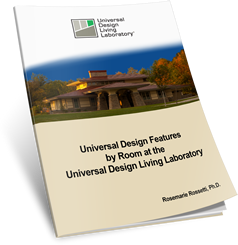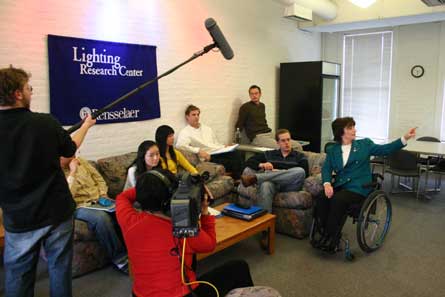
Discover how to live at home more affordably -- with independence, safety and dignity.
Get a sneak-peek at the "Universal Design Toolkit" with this free chapter filled with advice, tips and money-saving resources!

Build your awareness of what universal design features should be incorporated into homes.
Get the newly released "Universal Design Tookit", based on this real life demonstration home.

|
|
Article:
Lighting a Universal Design HomeAction Magazine
June 2006
By Rosemarie Rossetti
Copyright © 2006 Rosemarie Rossetti
Publication copyright © 2006 United Spinal Association
|

A documentary crew films the author and her young design team at the Lighting Research Center at Rensselaer Polytechnic Institute. Photo by Mark Leder.
I never paid much attention to the thought process that went into lighting a home until it was time to build my own. When I built my first home 11 years ago, I relied on an interior designer friend of mine to place the lighting. My new home, the Universal Design Living Laboratory (which I described in the March 2006 Action), will be a national model for universal design. This time I’m doing my own research on how to light the home with safety, comfort, energy efficiency, and appearance in mind, using the latest technology.
As I networked with professionals in the building industry, I was fortunate to meet a lighting designer, Patricia Rizzo, who is on the faculty of the Lighting Research Center at the Rensselaer Polytechnic Institute in Troy, New York.
Rizzo, her faculty colleague Russ Leslie, and seven graduate students offered to work with my husband Mark Leder and I. Rizzo has taught me much about lighting issues I’d never thought to address.
We’ve looked at such functions of lighting as wayfinding, security, and safety. As the students designed our new home, it was obvious to me that lighting can be beautiful and seamlessly integrated into the design. There are many ways to light a room, each setting for a different use. In the same room, for example, dim lighting can set the mood for relaxation, but with a flick of a switch, bright lights change the mood for a festive party.
I’ve realized, as I have aged (I am 52 years old ), that I need more light in order to read, prepare meals, and do close-up work like sewing. My mother, at age 91, often comments on her sensitivity to glare from sunlight coming through the window or from a glossy surface or bright source. Research shows that people have a reduced ability to adapt to extreme changes in brightness after they turn 65. Pupils in our eyes get smaller as we age. What this means for us “baby boomers” and seniors is that homes need more lighting and better shielding to prevent glare.
In order to reduce glare from solid surfaces such as countertops, building products with a matte finish should be selected. For my new home, I have chosen the no-glare “leather finish” of Silestone®, a countertop material made of quartz, for the kitchen and bathroom counters. This material has the added benefit of containing Microban®, which inhibits the growth of mold and bacteria in the countertops.
A person building a home using universal design principles should make sure that lights are shielded for occupants who have the lower vantage point of a seated position in a wheelchair. This comes into play especially in the kitchen when placing lights under the upper cabinets.
Light switches should be accessible––approximately 36” from the floor––easy to use and easy to find. The lighted rocker style is ideal, and dimmer switches are a delightful alternative. In the kitchen, avoid placing switches behind the countertop on the back wall. Additional switches may need to be integrated into the base cabinets.
One of the most surprising pieces of information I’ve learned from working with Rizzo is that compact fluorescent lighting is not only energy efficient, but it transmits high-quality light. The stereotype of fluorescent bulbs being too “cold” in color, or not being able to be controlled with dimmers, is no longer true.
To help find our way at night, we are adding night lighting to provide navigation cues. Small wayfinding lights can be embedded into walls and floors, by grab bars, or plugged into electrical outlets in strategic locations. New technologies, such as light emitting diodes (LEDs), lend themselves perfectly to these situations.
Since I work at home during the day, I can lower my need for electric lighting if I depend on natural sunlight for task lighting. Therefore, I am including more windows, skylights, sun tunnels, dormers and glass block in my new home, which will be very energy-efficient.
The lighting design students have completed the design for our new home and have computer rendered models of each of the rooms with the lights on. The lighting effect that they have created is stunning! Lighting designers can transform a room from ordinary to exceptional. Seeing is believing!
Rosemarie Rossetti, Ph.D. is building a national model universal design home in metropolitan Columbus, Ohio. She is an internationally known speaker, trainer, consultant, and writer. For more information or to contact her, visit her Web site at www.RosemarieSpeaks.com.